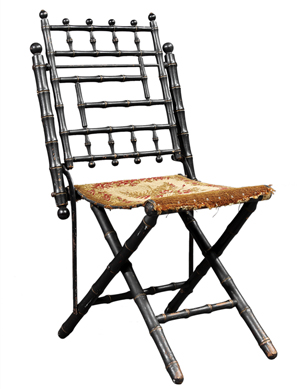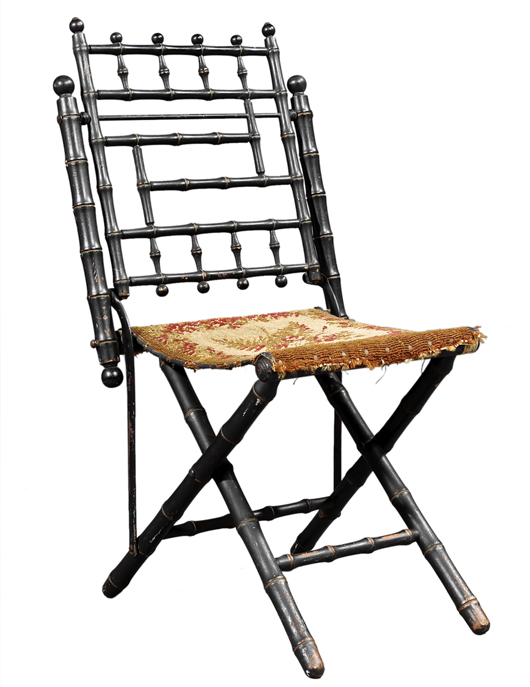
BEACHWOOD, Ohio – Expensive woods like teak or mahogany, marble, stone and other materials used to make expensive furniture are often imitated by a painted surface. Faux finishes have been used since the days of ancient Egypt. The Greeks and Romans admired murals that were examples trompe l’oiel (fool-the-eye) paintings.
Life-size objects on tables, half-open doors, stairways and furnishings included in these paintings looked real. The tradition of faux finishes experienced a resurgence in the 19th century. A major Civil War monument with an interior of pink marble walls was restored a few years ago. It was discovered during the restoration that the monument’s walls were actually made of white marble painted with a faux finish that made the wall look like expensive pink marble. No doubt it was done to save money – and it was so well done it fooled the public.
Inexpensive wood used to make furniture has been painted to resemble mahogany, bamboo, teak, bird’s-eye maple or just decorative graining. Tabletops were “improved” with a faux marble finish. Talented artists also painted tops with what looked like multicolored mosaic designs.
Bamboo furniture was the rage in the early 1800s. Bamboo was hard to get in Europe and the United States, so Chinese-style furniture was made with wooden parts shaped like bamboo, then painted with trompe l’oiel graining. The wooden parts were stronger than real bamboo, so the faked parts often were an improvement.
The tradition of painted furniture has continued, and collectors pay a premium for American “grained wood” country pieces made from 1850 until about 1880. But the finish must be original and in good condition.
Q: Can you tell me if the old Franciscan earthenware pattern named Sierra Sand contains lead?
A: Franciscan china was fired at high temperatures and is safe, but you can buy a lead-testing kit at a hardware store or online and test it yourself to see if the glaze contains lead. Lead-free glazes have been required on dinnerware sold in the United States since the 1980s. But glazes may contain some lead and still be considered “lead free,” according to U.S. Food and Drug Administration guidelines. If the pottery was fired at the correct temperature for the right amount of time, the lead fuses to the pottery and does not leach off. While your Franciscan dishes are safe, watch out for any pottery made in Mexico or China, handcrafted pottery, pieces that are highly decorated or have decorations painted over the glaze, and pottery with orange, red or yellow glaze.
Q: An uncle in Ireland gave us an old clock. The inscription on the face of the clock is “Lepaute, Hger Du Roi.” It has Roman numerals for the hours and Arabic numerals for the minutes. Do you have any idea how old the clock is and what it might be worth?
A: The Lepautes were master clockmakers in the 18th century. Jean-Andre Lepaute (1720-1789) began making clocks in Paris in about 1740. He specialized in large clocks for public installations and invented several improvements to clocks. He was a “Horloger du Roi,” a clockmaker to the king, by 1751. His brother, Jean-Baptiste (1727-1802), joined him in business in 1759 and became head after Jean-Andre retired in 1774. After Jean-Baptiste died, his nephews ran the business for several years. Some clocks by Lepaute sell for several thousand dollars. Your clock would need to be seen by an expert to determine its value. A famous 1765 mantel clock has auctioned for $111,462.
Q: My father found a metal Coca-Cola serving tray in the attic of a railroad depot being torn down in Fayette, Mo., in the early 1980s. It has been hanging in my parents’ home ever since. I have tried researching it but haven’t had any luck. The tray is rectangular and 24 by 34 inches. It has a green border surrounding a red inner border. In the center is a picture of a woman in a white gown wearing a tiara and holding an open black fan. Her right elbow is resting on an elaborate pedestal with flowers on it. The words on the tray are: “Delicious, Refreshing, Drink Coca-Cola, At Fountains 5 cents, In Bottles 5 cents.” Can you help?
A: Your tray is a reproduction that dates from the late 1960s or ’70s. The woman pictured is Lillian Nordica (1857-1914), a famous American opera singer. Coca-Cola used her image on oval serving trays in 1905. A 1975 tray similar to yours, but with a bottle of Coke on the pedestal was made to celebrate the 75th anniversary of an Atlanta bottler. That tray, with a history printed on the back, sells for about $20 today. Other trays like yours have a glass of Coke on the pedestal. Many authorized and unauthorized reproduction and “fantasy” Coca-Cola trays (a fantasy tray uses an old image but doesn’t copy a vintage tray) have been made since the 1970s. They sell for $5 to $75, depending on quality, condition, rarity and whether or not the tray was authorized by the company or a bottler.
Tip: Re-glue a doll’s wig with rubber cement. It’s removable if you later want to change the wig.
Sign up for our free weekly email, “Kovels Komments.” Terry writes about the latest news, tips and questions and her views of the market. If you register on our website, there is no charge.
Terry Kovel and Kim Kovel answer questions sent to the column. By sending a letter with a question, you give full permission for use in the column or any other Kovel forum. Names, addresses or email addresses will not be published. We cannot guarantee the return of photographs, but if a stamped envelope is included, we will try. The amount of mail makes personal answers or appraisals impossible. Write to Kovels, Auction Central News, King Features Syndicate, 300 W. 57th St., New York, NY 10019.
CURRENT PRICES
Current prices are recorded from antiques shows, flea markets, sales and auctions throughout the United States. Prices vary in different locations because of local economic conditions.
- Hull planter, white Siamese cat and kitten at rest, green paws base, 12 inches, $40.
- Popeye Pez dispenser, blue base, 4 inches, $45.
- Dog dish, Hudson’s Soap ad, cast iron, white, black paint, circa 1910, 16 inches, $155.
- Capo-de-Monte pitcher, man-on-the-mountain handle, painted cherubs, 16 inches, $210.
- Old Salt bookends, Cape Cod fishermen, cast iron, painted, Connecticut Foundry Co., 1928, 5 1/2 inches, $210.
- Neoclassical-style chair, beech, needlepoint upholstery, carved arms and frame, pair, $530.
- Firehouse toy, wood, painted, faux stone exterior, two stories, two doors, 30 x 37 inches, $565.
- Music box, Concerta, interchangeable cylinder, burled panel inlay, three cylinders, Ideal, 31 x 16 inches, $595.
- Tiger-skull smoking set, silver mounting, applied insets, Siam, 10 x 13 inches, $1,295.
- Keynoil Motor Oil can, metal, White Eagle Oil & Refining Co., 1 gallon, $1,300.
The Kovels have navigated flea markets for decades. Learn from the best. Kovels Flea Market Strategies: How to Shop, Buy and Bargain the 21st Century Way, by Terry Kovel and Kim Kovel, tells you about the latest smartphone apps and websites to help you shop, share and ship. It also clues you in about what to wear, what to bring and, most important, how to negotiate your way to a bargain. Also find tips on spotting fakes, advice about paying for your purchases, and shipping suggestions. Full-color booklet, 17 pages, 8 1/2 by 5 1/2 in. Available only from Kovels for $7.95 plus $4.95 postage and handling. Order by phone at 800-303-1996; online at Kovels.com; or mail to Kovels, Box 22900, Beachwood, OH 44122.
© 2014 by Cowles Syndicate Inc.

ADDITIONAL IMAGE OF NOTE



